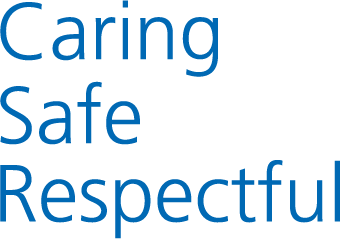Please be aware that most of these links will take you to third-party websites.
Videos:
- Introduction to Dysphagia
- International Dysphagia Diet Standardisation Initiative (IDDSI)
- A guide to thickening fluids
- Chef's Council Nutilis Masterclass
Advice sheets:
- Level 7: Regular diet
- Level 7: Regular diet, easy to chew diet
- Level 6: Soft and bite-sized diet
- Level 5: Minced and moist diet
- Level 4: Smooth pureed diet
- Level 4: Extremely thickened fluids
- Level 3: Liquidised diet
- Level 3: Moderately thickened fluids
- Level 2: Mildly thickened fluids
- Level 1: Slightly thickened fluids
- Level 0: Thin fluids
What is dysphagia?
Dysphagia is the term used to describe swallowing difficulties. Some people may have problems swallowing certain types of food or drinks or both. Some people may not be able to swallow at all. Someone who cannot swallow safely may not be able to eat or drink enough to stay hydrated or maintain an ideal weight. Food or liquid can enter the wind pipe and may enter the lungs; this can cause harmful bacteria to grow, resulting in a lung infection called aspiration pneumonia. Food entering the wind pipe can also cause choking which is a complete or partial blockage of the windpipe. Dysphagia can also cause long-term health problems if it is not treated.
What causes dysphagia?
There are many different causes of swallowing difficulties, these may include:
- a neurological event such as stroke
- neurological disease such as Parkinson’s Disease, Motor Neurone Disease, Dementia
- respiratory disease such as Chronic Obstructive Airways Disease
- head and neck cancers
- learning disability
What are the signs of dysphagia?
There are immediate signs and longer-term signs of swallowing difficulties. These may include:
- difficulty chewing
- persistent drooling of saliva
- coughing or throat clearing whilst eating or drinking
- refusing certain food, drink or medication
- losing food/drink/saliva out of the mouth
- food becoming stuck in cheeks or the roof of mouth
- taking a very long time to finish meal or drink
- discomfort/pain on swallowing
- change of face colour or watery eyes
- ‘wet’ or gurgly voice
- gagging, regurgitating or vomiting
- choking
Longer term signs include weight loss; dehydration; constipation; urinary tract infections; and repeated chest infections.
How is dysphagia treated?
Various professionals work with people who have dysphagia. This may include a Speech Language Therapist (SLT), Dietician, Occupational Therapist (OT), and Physiotherapist.
The goal of dysphagia treatment is to find the safest, most efficient, and most enjoyable way for you to eat.
Treatments may include:
- Sitting in positions when eating that make up for weakness
- Following recommendations that include safe liquids and foods
- Using advised safe-swallowing strategies
- Doing exercises to strengthen the neck and facial muscles that help you swallow
- Other forms of feeding – such as tube feeding through the nose or stomach
What can you do to help?
- Ensure you are optimally positioned and alert
- Don’t rush meal times
- Do not complete other activities during a meal time
- Reduce distractions when eating and drinking
- Follow recommendations from professionals – for example, giving foods and drinks which are the consistency or texture advised
- Eat and drink slowly, do not over fill your mouth
- If you are not able to feed yourself, your carer will be asked to assist you at a slow pace, giving you their full attention.
- Use appropriate cutlery or adaptations if these have been recommended by a professional.
Call 999 if when you are eating and/or drinking you:
- cannot stop coughing
- having difficulty breathing; or
- are choking
Also contact the Speech and Language Therapy Department, when able (01253 953873), so that we can arrange a review of swallowing if necessary.
The following strategies are for people who experience difficulty swallowing (dysphagia). Dysphagia can be very serious as it can cause food or liquid can enter the wind pipe. This may enter the lungs which can cause harmful bacteria to grow, resulting in a lung infection called aspiration pneumonia. Food entering the wind pipe can also cause choking which is a complete or partial blockage of the windpipe.
Following the advice below, may reduce the risks associated with dysphagia.
- if you wear dentures, try to wear them when eating (use adhesive to help them fit). Remove them if they are too loose and move around in your mouth.
- reduce distractions whilst eating/drinking eg: no talking, no TV.
- sit in an upright position at all times when eating and drinking.
- keep your head in a neutral position or slight chin tuck when swallowing.
- avoid foods that you know are problematic (examples may include bread, hard meat, dual consistency foods such as minestrone soup or cereal)
- eat and drink slowly, have small mouthfuls, 1 at a time
- chew food well (into a mashed consistency) before you swallow
- make sure you swallow each mouthful before taking the next
- watch out for any signs that you are fatiguing or may be aspirating (i.e. that food/drink may be entering your lungs). These signs include:
- Coughing or choking whilst or after eating/drinking
- A gurgly or wet sounding voice
- ‘Bubbly’ or ‘rattly’ sounding breathing whilst or after eating/drinking
- Rapid breathing whilst or after eating/drinking
If any of these signs are observed, STOP eating/drinking. Resume if you are settled and have no difficulty breathing.
Call 999, if you cannot stop coughing, are having difficulty breathing or are choking.
Also contact the Speech and Language Therapy Department, when able (01253 953873), so that we can arrange a review of your swallow if necessary.
What are high risk foods?
High risk foods are foods which are harder to chew or swallow. Your Speech and Language Therapist will advise you if you need to avoid these foods or if you can continue to eat them if safe to do so.
The following list is a guide only and does not list all high- risk foods. If you have any concerns, please contact your speech and language therapist.
| Texture | Types of food |
|---|---|
| Dry, crumbly foods | Biscuits, crackers, toast, cake, pie crust, crumble, granola, coconut |
| Foods that become claggy | Bread, some pastas |
| Hard foods | Boiled lollies, nuts, sees, raw vegetables, hard raw fruits like apples |
| Tough or chewy foods | Tough meats such as steak, bacon, dried fruit, chewy sweets |
| Stringy or fibrous foods | Pineapple, celery, broad beans, rhubarb, onions, some meats, pickled vegetables, lettuce |
| Vegetable and fruit skins | Orange segments, grapes, tomatoes, peppers, potatoes, apples |
| Food with husks | Corn, peas, lentils |
| Mixed consistency foods | Cereals that do not absorb milk such as muesli, mince with thin gravy, soup with lumps like minestrone |
| Foods with pips and seeds | Avoid all pips and seeds |
| Juicy foods - juice separates from food within the mouth | Watermelon, orange segments, grapes |
Some high risk foods can be modified or prepared in such a way that it makes them easier and safer to eat. For example:
Bread - consider these options when preparing bread:
- Sandwich thins
- Remove crusts
- Toast with plenty of butter
- Soaking bread in soup
- Avoid seeded bread
- Add mashed or moist fillings
- Soft bread
- Avoid thick cut bread
Sweet biscuits:
- Dip biscuits in milk or a warm drink to moisten
Dry cake:
- Add extra moisture with ice-cream, cream or custard
What is Aphasia?
Aphasia is a communication disorder which may affect someone’s ability to speak, understand what others are saying, read, write and use numbers. Aphasia can be very mild, and sometimes only affects one form of communication, such as reading. However, it is more common for several areas of communication to be affected at the same time. Aphasia usually occurs suddenly, often as the result of a stroke or head injury, but it may also develop slowly, as in the case of a brain tumour, an infection, or dementia.
People with aphasia may:
- Have difficulty understanding what other people say as though others are talking in an unknown foreign language.
- Not understand others if there is background noise or if different people are talking in a group.
- Be able to read newspaper headlines, but not understand the rest of the text.
- Be able to write but unable to read back what they’ve written.
- Not be able to speak at all. They may communicate by making sounds but not be able to form words. They may get stuck on a single word or sound and end up repeating it.
- Much of what they say may be unrecognisable and has limited meaning. They may not realise this and others may wrongly think they are confused.
- Have difficulty speaking in sentences. They may say only single words or very short sentences, missing out crucial words. They may write in a similar way.
- Answer ‘yes’ or ‘no’ however mean the opposite so their answers are not reliable.
- Think of the word they want to say, but another word comes out – for example, ‘milk’ instead of ‘water’.
- Describe or refer to objects and places, but not be able to name them.
- Say only a few set words, they may be emotional words, such as swear words.
How can you help?
It is important to help the person experiencing communication difficulties to express their needs, wants, opinions and feelings in a way that makes them feel valued and heard.
It is also important to acknowledge that whilst the person may have difficulty communicating, it does not mean this has affected their intelligence. Helpful strategies include:
- Use a friendly tone of voice that is not condescending
- Include the person in conversation, try not to talk around them or for them
- Maintain a natural conversational manner appropriate for an adult.
- Acknowledge communication breakdowns and frustration felt by the person and yourself
- Include the person with aphasia in conversations.
- Ask for and value the opinion of the person with aphasia.
- Minimize distractions, such as a loud radio or TV, whenever possible.
- Allow the person plenty of time to talk and check understanding by asking yes/no questions.
- Speak slowly and use short phrases that convey one key message at a time eg: “We are going to the park”
- Ask questions one at a time, and phrase them in a way that allows for a ‘yes’ or ‘no’ answer (eg rather than asking someone what they would like to do, ask if they would like to go for a walk) or in a way that gives the person a choice (eg ‘would you like tea or coffee?’).
- Rephrase if you are not understood. Sometimes repeating what you say doesn’t help. Try rephrasing to get the message across in a simpler way. Use other forms of communication to get your message across eg: gesture, pointing to picture or object, writing a word.
- Encourage any type of communication. Ask the person to gesture, point to objects or pictures, or write key words, such as “Can you show me…”
- Avoid correcting the person’s speech.
Communication Strategies
What is Dysarthria?
Dysarthria a difficulty producing speech sounds characterised by a weakness of the muscles used in speech production. These muscles include the face, lips, tongue, jaw, voice box and muscles of breathing. Symptoms may include:
- Slurred or unintelligible speech
- Speech which is too fast or too slow or too quiet
- Running out of breath when speaking
- A voice which sounds harsh, strained or breathy
- Changes in pitch causing the speaker to sound ‘monotonous’
- Drooling of saliva (One side of the face may be weaker than the other. Weakness of the tongue and lips may mean there is dribbling of saliva, food and drink).
Communication Strategies
Try to remember these following tips:
- Sit as upright as possible when talking to others
- Face the person you are talking to
- Reduce distractions and back ground noise – turn off the TV, radio or go to a quiet area.
- Take deep breaths when talking
- Speak slowly and deliberately
- Say each word clearly, being careful not to miss sounds in the middle and end of words eg: chocolate
- Break longer words up, saying each part separately eg: in – the – af – ter – noon
- Use short sentences eg. “I want to go out for a drive in the car.” may be expressed as, “Let’s go out in the car.”
- Don’t change topic suddenly
- Repeat if you are not understood. Avoid repeating everything, just the key words
- Use any means of communication to supplement speech, e.g. alphabet chart, gesture, drawing. Keep a paper and pencil nearby for writing.
- Practice speaking clearly by reading aloud to yourself – take a deep breath before speaking, over articulate the words, take regular breaths.
How your listener can help
- Ensure the surroundings are quiet and free from distractions
- Give positive feedback when you have understood. Give the person time to talk
- Repeat back the part of the message you have understood.
- Maintain close eye contact so you can watch the speaker’s facial expression and make extra effort to listen carefully
- Encourage all speech efforts, reminding the person to go slowly, to use one or two words at a time and pause regularly
- Ensure there is a paper and pencil or alphabet chart to use to supplement speech
- If writing is unclear, use a list of words to be pointed to, or encourage drawing
- Help the person to read aloud slowly and deliberately from a newspaper or magazine to practise speech
- Do not pretend you have understood if you have not. The speaker may realise and become upset or frustrated
- Ask for repetition of key words that you may have missed, eg. “Where did you go for a drive?”
- Repeat back to the person to clarify that you have understood correctly, eg. “Was that ‘Let’s go out?’“
- Remind the person that their speech will be worse when tired, upset or unwell. This is the time to rest.
What is Supported Communication?
Supported communication is an approach which attempts to enable a person with communication difficulties to express their needs, wants, opinions and feelings in a way that makes them feel valued and heard.
This is done by both the listener and the person using a set of communication methods which supports the person to express themselves.
It is important for the listener to:
- Minimise distractions, such as a loud radio or TV, whenever possible.
- Use a friendly tone of voice that is not condescending
- Maintain a natural conversational manner appropriate for an adult.
- Acknowledge communication breakdowns and frustration felt by the person.
- Allow the person plenty of time to communicate
- Avoid correcting the person’s speech
- Be prepared!
Supported Communication strategies:
YES/NO QUESTIONS:
- Simple yes/no questions can be used to:
- offer options: “Do you want to go for a walk?”
- confirm understanding: “I think you want a cup of tea. Is that right?”
- clarify meaning: “I know you want to tell me something. Is it about your family?”
- Remember to stick to one topic per question. For example, avoid questions that have multiple parts like “Do you want to eat breakfast or should we go for a walk first” or that are open ended “What would you like to do today?”. If the person was to answer “yes” to either of these questions you still wouldn’t be sure about what they wanted to do.
- If you are unsure of what the person wants to tell you, start by asking more general yes/no questions until you find the topic of what they are talking about, then you can ask more specific questions. For example:
-
- You: “Is it about money?” Response: “No”
- You: “Is it about family?” Response: “No”
- You: “Is it about an activity?” Response: “Yes”
- You: “Is it something to do inside?” Response: “No”
- You: “Is it something to do outside?” Response: “Yes”
- You: “Do you want to go for a walk?” Response: “No”
- You: “Do you want to go to the shops?” Response: “Yes”
- If the person gets yes/no responses muddled up, try using thumbs up/thumbs down, pointing to a piece of paper with yes/no written on it OR tick/cross OR happy face/sad face
READING:
- Writing down a short list of options for the person to choose from can also help them get their message across. For example, you may have established that they want a drink by asking yes/no questions. Instead of continuing asking yes/no questions until you find out what they want, you could write a short list of drinks for the person to choose from eg:
-
- WATER
- COFFEE
- JUICE
-
WRITING:
- Can the person write or point to an alphabet chart? If so, can they spell out key words or the first few letters of a word to help you understand their message?
DRAWING:
- Can the person draw a basic picture of what they are trying to say? For example if they wanted to watch the golf on TV, could they draw a TV and a golf stick.
GESTURE:
- Can the person use gesture/mime to get their meaning across? For example, if they wanted to go for a walk, could they use their fingers to gesture a walking motion.
POINTING:
- Encourage the person to point to what they want
RESOURCES:
- Gather items such as pictures, objects, alphabet charts, maps, newspapers, pen and paper to help the person get their message across. For example, if you are having a conversation about holidays, look at Google Maps and ask the person to show you where they have been on holiday or where they would like to go.
What is a Word Finding Problem?
When we are speaking, we are constantly retrieving the correct words to use from the language centre in our brain. When someone experiences difficulties with word finding, they know what they want to say and understand the particular word they are looking for, however have difficulty retrieving it to use in their speech. It may feel as if the word is on the “tip of their tongue”. Problems finding the right word/s to say when speaking can be extremely frustrating. This frustration can make matters worse. Word finding difficulties may be caused by but not limited to:
- Stroke or Brain Injury
- Dementia
- Depression and anxiety
- Stress
- Ageing
Word Finding Strategies
Usually you know the word you are trying to say, you just cannot retrieve it. There are lots of things you can do to help:
- Give yourself time, stop and think before you speak
- Keep it short and simple. Only say what you need to say. Fewer words may give you more of a chance at getting your message across.
A hint or a clue might help you find it more quickly. You can do this by talking about the word itself. By talking about the word, you will either be able to retrieve the word or give your listener enough information so they can guess the word for you. You can do this by talking about things like:
- What sound does the word start with?
- What other word does it rhyme with?
- What is it opposite to?
- What category does it belong to?
- What is it used for?
- What does it do?
- What are its properties (“It has…..”, “It’s made from…..)
- Where is it found?
- What does it remind you of?
- What colour is it?
- What does it feel/smell/taste like?
Other word finding strategies include:
- Saying a similar word if you cannot think of the exact word eg. “cup” for “glass”
- Point to an object, picture, photo that may give a clue to what you are trying to say
- Gesture what you would do with it
- Write it down, even if you can only get a part of the word
- Draw a picture or a diagram
- Make a sound that would be associated with the word eg. sing or hum a TV jingle as a clue to a TV show.
Word Finding Activities
The below activities will help you practice using the strategies above.
- Simple cross words
- Word description game – 2 players:
- write down a list of words (start simple) or ask someone to write a list for you eg: apple, chair, mug, gloves, phone.
- pick a word from your list
- without saying the word, describe the word using the strategies above eg: target word is apple “It is a piece of fruit, it grows on a tree, it’s red or green, you can make a pie with this fruit”.
- The listener has to guess the target word from what you say
- Take it in turns being the describer and the listener
- Therapy Apps – if you have access to a smart device, you can download word finding therapy apps such as Tactus Naming Therapy or Talk Around It
How others can help you
Other people can help you by reminding you to “talk around the word” and asking you questions to help with this eg: “Where do you find it?...can you draw it for me?”. If they know the word you are trying to say, they could cue you in by giving you a phrase to find the word. For example, if they knew you were trying to think of the word key they could say “Lock and ____” or a phrase and sound cue eg: “Lock and k____”.
Resources:
Videos:
Other resources:
Services:
Videos:
Other support:



